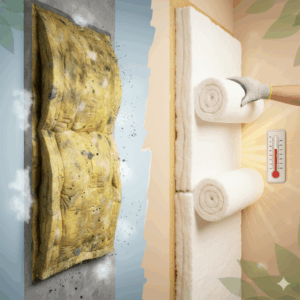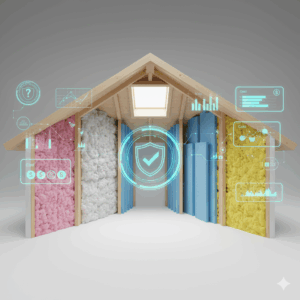When deciding on attic insulation, homeowners often weigh Blown in vs Batt Insulation to determine which method best suits their home’s needs. Both options have unique installation methods, R-values, and cost considerations. Blown-in insulation is typically loose-fill cellulose or fiberglass, while batt insulation comes in pre-cut rolls, often made of fiberglass. Understanding the differences helps homeowners select a solution that maximizes energy efficiency and comfort.
Why Choose Blown-in vs Batt Insulation?
Selecting between blown-in and batt insulation requires evaluating performance, cost, and installation preferences. Many homeowners also consider professional home insulation services to ensure proper installation. These services guarantee even coverage and adequate thickness for long-term efficiency. Additionally, investing in home insulation services can help prevent gaps, air leaks, and improper R-value that reduce the insulation’s effectiveness.
Benefits of Blown-in Insulation
Blown-in insulation offers several advantages. Its loose-fill nature allows it to settle into nooks, corners, and irregular spaces in the attic, providing consistent coverage. The installation process, often referred to as blow insulation into attic, ensures minimal gaps and better thermal performance. Blown-in insulation is also effective at reducing sound transmission and is available in eco-friendly cellulose options. Homeowners evaluating their attic may also consult Does My Attic Have Enough Insulation? to assess current insulation levels before installation.
Pros of Batt Insulation
Batt insulation, including batt fiberglass insulation and fiber glass batt insulation, is a traditional choice due to its straightforward installation. Pre-cut rolls fit standard spacing between joists, making DIY installation feasible. Batt insulation is widely available, easy to handle, and generally lower in upfront cost compared to blown-in options. However, achieving perfect coverage can be challenging, especially around obstructions, potentially creating gaps that reduce efficiency. Types Of Attic Insulation Materials provides a detailed guide to different batt options and their respective benefits.
Comparison of Blown-in vs Batt Insulation
| Feature | Blown-in Insulation | Batt Insulation |
| Installation | Professional or DIY with blower | DIY or professional |
| Coverage | Fills gaps & irregular spaces | Fits standard joist spacing |
| R-Value | Consistent if properly installed | Can vary with gaps |
| Soundproofing | High | Moderate |
| Cost | Moderate to high | Low to moderate |
Cost Considerations
The blow insulation cost can vary depending on attic size, material choice, and labor. Blown-in cellulose or fiberglass typically costs more than batt insulation but may provide better long-term energy savings. Conversely, batt insulation is generally cheaper upfront but requires careful placement to avoid gaps. Homeowners can review What is the Costs of Attic Insulation for detailed pricing and ROI comparisons.
When to Choose Blown-in Insulation
Blown-in insulation is ideal for attics with uneven joists, obstacles, or areas requiring additional coverage. It can be added on top of existing insulation to increase R-value without removing old material. Homeowners should consult How Much Attic Insulation Do I Need? to calculate the exact amount required for their attic to achieve optimal energy efficiency.
When to Choose Batt Insulation
Batt insulation is often suitable for new construction or open spaces with standard joist spacing. Its straightforward installation makes it a common choice for DIY enthusiasts and budget-conscious homeowners. However, professional guidance is still recommended to ensure proper placement and avoid compression that lowers the insulation’s effectiveness. Pros & Cons Of Attic Insulations provides insights into both methods for homeowners to make informed decisions.
Removing Old Insulation
Older insulation materials may need removal before installing new insulation, especially if damaged or insufficient. Costs vary based on material type, contamination, and disposal requirements. Homeowners can reference Attic Insulation Removal Cost: Complete Overview to understand removal expenses and how it impacts total installation costs. Proper removal ensures the new insulation performs efficiently and prolongs energy savings.
Energy Efficiency and Environmental Impact
Both blown-in and batt insulation can improve energy efficiency by reducing heat loss in winter and heat gain in summer. Blown-in insulation tends to provide superior coverage, reducing drafts and thermal bridges, while batt insulation may require meticulous installation to achieve similar performance. For those integrating insulation with modern technology, When Does Attic Insulation Need To Be Replaced? explains the signs of worn-out insulation and when upgrades are necessary.
Cost Comparison by Attic Size
| Attic Size | Blown-in Insulation | Batt Insulation |
| 500 sq ft | $500 – $1,250 | $400 – $1,000 |
| 1,000 sq ft | $1,000 – $2,500 | $800 – $2,000 |
| 1,500 sq ft | $1,500 – $3,750 | $1,200 – $3,000 |
Maintenance and Longevity
Blown-in insulation can settle over time, potentially reducing R-value, but it can be topped up easily. Batt insulation maintains its thickness longer but may be prone to gaps if compressed. Regular inspection and maintenance are critical to ensure optimal performance and energy savings. For more information, homeowners can also consult Does My Attic Have Enough Insulation? to evaluate the condition of their attic.
Conclusion
Choosing between Blown in vs Batt Insulation requires considering attic structure, budget, and long-term energy efficiency goals. Both options provide excellent thermal performance when installed properly, but professional guidance can maximize benefits. Homeowners can rely on Guardian Home Energy for expert installation, accurate cost estimates, and top-quality home insulation services that improve comfort and reduce energy bills.
FAQs
- What is the main difference between blown-in and batt insulation?
Blown-in insulation is loose-fill and fills gaps effectively, while batt insulation comes in pre-cut rolls for standard joist spacing.
- Can I install batt insulation myself?
Yes, batt insulation is DIY-friendly, but careful placement is needed to avoid gaps.
- Is blown-in insulation more energy-efficient?
It often provides better coverage and fewer gaps, increasing energy efficiency compared to batt insulation.
- How much does it cost to blow insulation into the attic?
Costs vary by attic size, material type, and labor, generally $1.00–$3.50 per sq ft.
- How long does insulation last?
Properly installed blown-in or batt insulation can last 20–30 years, with periodic inspections recommended.





